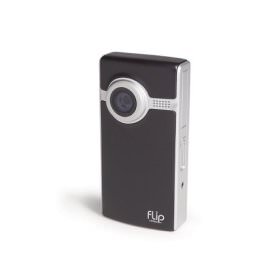This chapter explains how to use video to tell a story. Video is often a more effective tool than words or pictures. A journalist in today’s world needs to have the knowledge and ability to shoot and edit video, and this chapter helps with the basics.
Video has recently become something that everyone can become involved in. The equipment has become more affordable and user friendly. According to the book, YouTube reported in 2009 that 20 hours of video gets uploaded every minute. Journalists need to learn how video can effectively be used to better tell a story.

The Flip Cam is an affordable option for anyone looking to shoot quality video. Image from groundreport.com
Video journalists, or backpack journalists, serve as both a reporter and a videographer on any certain assignment. They are becoming more common in the modern era because it is less expensive. A journalist that has experience with video has a great advantage over any competition.
A great use of video is during an interview. Video interviews are one of the most basic forms of journalism. The book gives a few tips for preparing for a video interview:
- Write a script and warm up.
- Be stable, breathe easy
- Don’t be afraid to talk with your hands
- Control your story with voice-overs
It is also important to learn how to properly edit your video. Make sure you shoot enough while you have the chance. You can always cut the footage short, but you can never add more. Most computers will have some sort of editing software standard. However, editing programs are becoming more affordable all the time. It might be a good idea to spend some money on a higher quality program.
 No Comments »
No Comments »
As is states in the introduction, journalism without photos is like writing without words. Digital technology has made it possible to publish pictures almost immediately after they are taken with just a few clicks. However, effectively publishing digital photos takes practice and patience. This chapter explains what a journalist will need to know.

Image courtesy of: howstuffworks.com
In this modern era, digital photography has become the preference of most because of its many benefits, including:
- Not having film limit the amount of pictures that can be taken
- The ability to immediately see whether or not you captured the image you wanted
- The ability to upload pictures to the internet
- Saving money by printing only the pictures you want
- Easy editing of photos, such as cropping, on your computer
By now, digital camera use is pretty simple to most college students. You point and click to shoot the image and look on the camera’s display to make sure its what you want. Then there are the zoom and flash features if you need a close up or more light.
After you have the images you need, it is time to edit them. Cropping and resizing photos can be important depending on what you need them for. However, it is possible to do more harm than good if you are not careful. According to the Code of Ethics of the National Press Photographers Association, you should never “manipulate images or add or alter sound in any way that can mislead viewers or misrepresent subjects.”
Following these steps while editing your photos is a good way to make sure you get the most out of the program you decide to use.
- Edit a copy of the photo — never the original
- crop the photo
- resize the picture
- modify the resolution
- tone and color correct the picture
- save a web version
- keep it simple
Once you have your collection of photos, you will need a place to organize them. There are many sites online that let you upload, organize and share your photos with friends and family. Using these simple photography techniques can greatly improve the quality of your journalism.
 No Comments »
No Comments »



 Entries (RSS)
Entries (RSS)